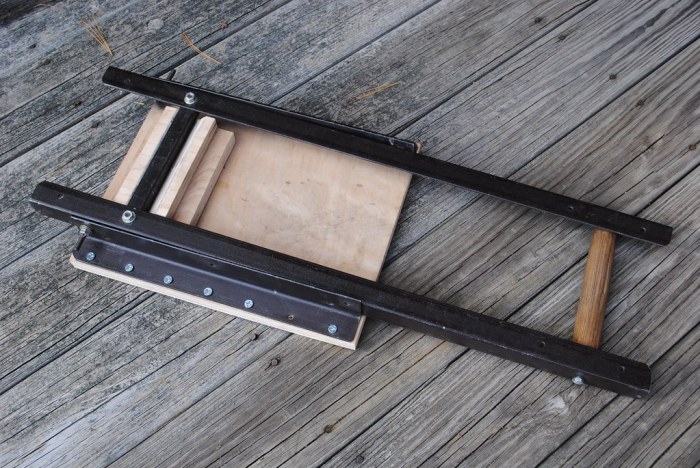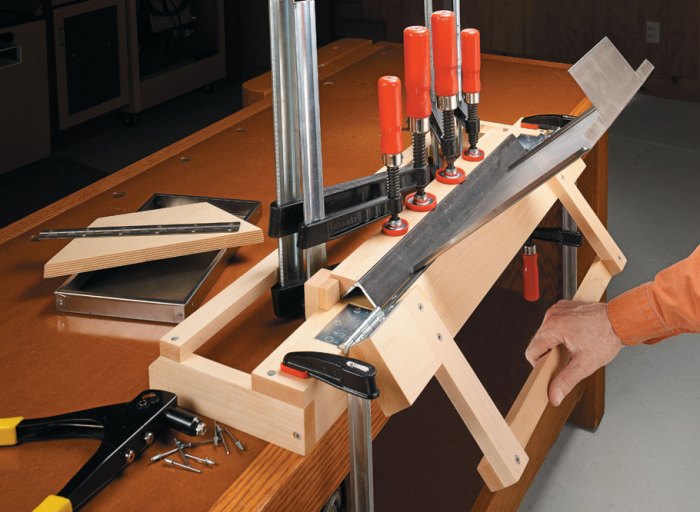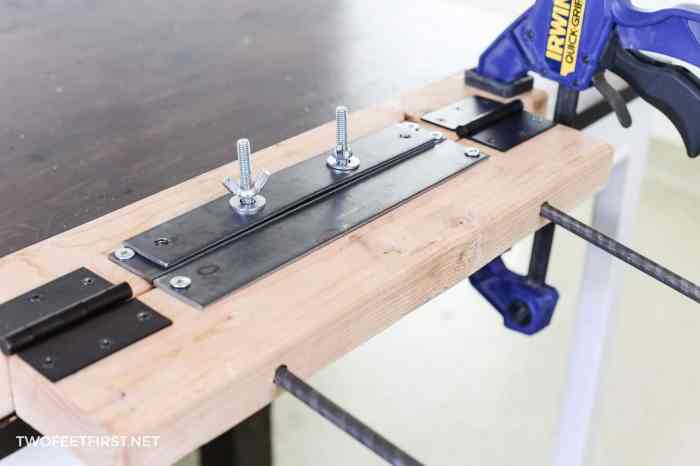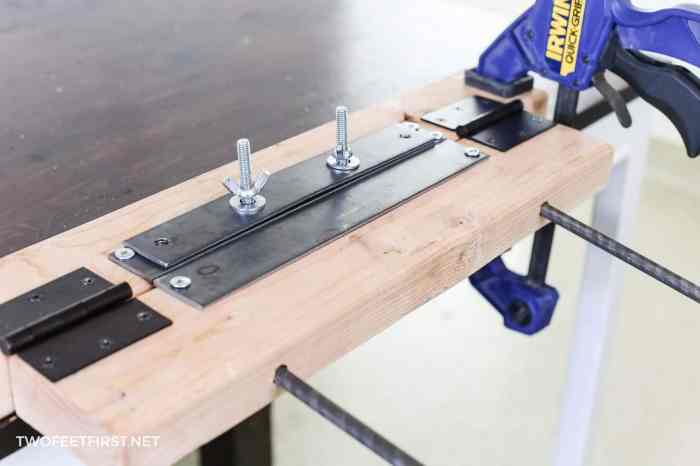DIY bending brake, a phrase that sparks curiosity in the minds of metalworking enthusiasts and DIYers alike. The ability to shape metal precisely, creating custom brackets, enclosures, or even decorative pieces, becomes attainable with a DIY bending brake. This project is not just about saving money on a commercial tool, but about the satisfaction of building something functional with your own hands.
This guide delves into the world of DIY bending brakes, covering everything from the basic principles of metal bending to the specific steps involved in designing, building, and using your own bending brake. We’ll explore different types of DIY bending brakes, discuss essential tools and materials, and highlight safety precautions. Whether you’re a seasoned metalworker or a curious beginner, this comprehensive guide will equip you with the knowledge and confidence to embark on your own DIY bending brake journey.
Safety Precautions
Working with metal bending tools and equipment can be dangerous if proper safety precautions are not taken. This section discusses essential safety measures to follow when building and using a DIY bending brake. It’s crucial to prioritize safety to prevent accidents and injuries.
Personal Protective Equipment (PPE)
Wearing appropriate PPE is essential for protecting yourself from potential hazards while working with metal.
- Safety Glasses: Protect your eyes from flying metal shavings and debris. Always wear safety glasses with side shields to ensure complete eye protection.
- Gloves: Protect your hands from cuts, abrasions, and heat. Choose gloves made of durable materials like leather or Kevlar, and ensure they fit properly.
- Hearing Protection: Protect your ears from loud noises generated by the bending process. Earplugs or earmuffs can effectively reduce noise levels.
- Work Boots: Protect your feet from falling objects and sharp metal edges. Steel-toe boots are recommended for added protection.
- Dust Mask: Protect your respiratory system from metal dust and fumes. Choose a dust mask that provides adequate protection based on the type of metal being worked with.
General Safety Practices
Following general safety practices is crucial for minimizing the risk of accidents.
- Clear Work Area: Keep your work area clean and free of clutter to prevent tripping or falling hazards.
- Secure Workpiece: Ensure the workpiece is securely clamped or held in place before bending to prevent it from moving or slipping.
- Use Proper Tools: Use tools designed for the specific task at hand. Avoid using tools that are worn or damaged.
- Avoid Distractions: Stay focused on the task at hand and avoid distractions while working with the bending brake.
- Use Proper Lifting Techniques: Lift heavy objects correctly to prevent back injuries. Use a lifting aid if necessary.
Safety Precautions for Building the Bending Brake
Building a DIY bending brake requires extra care and attention to safety.
- Follow Instructions Carefully: Read and understand all instructions and safety warnings before starting the project.
- Use Appropriate Tools and Materials: Use tools and materials that are strong and durable enough for the task at hand.
- Securely Fasten Components: Ensure all components are securely fastened to prevent them from coming loose during use.
- Test for Stability: Before using the bending brake, test its stability to ensure it is safe to operate.
Safety Precautions for Using the Bending Brake
Using a DIY bending brake requires specific safety precautions.
- Avoid Overloading: Do not exceed the bending brake’s capacity to prevent damage or accidents.
- Use Proper Bending Techniques: Apply pressure gradually and evenly to prevent the workpiece from buckling or breaking.
- Use a Backstop: Use a backstop to prevent the workpiece from flying back after bending.
- Be Aware of Pinch Points: Be aware of potential pinch points where fingers or hands can get caught.
- Keep Hands Clear: Keep your hands clear of the bending area while operating the brake.
Bending Techniques and Tips

A DIY bending brake allows you to create precise bends in various materials, but mastering the technique is crucial for achieving consistent results. This section explores various bending techniques, provides tips for accurate bends, and discusses common errors to avoid.
Understanding Bending Techniques, Diy bending brake
The choice of bending technique depends on the material’s thickness, desired bend radius, and the capabilities of your DIY bending brake.
- Air Bending: This technique involves bending the material using the force of air pressure. Air bending is often used for thin materials and can produce smooth, consistent bends.
- Bottom Bending: This technique involves bending the material over the bottom edge of the bending brake. Bottom bending is ideal for thicker materials and allows for tighter bend radii.
- Coining: This technique involves applying pressure to the material using a die to create a precise shape. Coining is commonly used for creating complex bends and intricate details.
Tips for Achieving Accurate Bends
- Use a Bending Die: A bending die helps to ensure consistent bend angles and radii. Choose a die that matches the desired bend radius and material thickness.
- Apply Even Pressure: Ensure even pressure is applied throughout the bending process. This prevents uneven bends and wrinkles in the material.
- Use a Backstop: A backstop helps to prevent the material from buckling during the bending process. Position the backstop correctly to achieve the desired bend angle.
- Practice with Scrap Material: Before bending your final material, practice on scrap pieces to familiarize yourself with the bending process and fine-tune your technique.
Common Bending Errors and How to Avoid Them
- Uneven Bends: Uneven bends are caused by uneven pressure application during the bending process. To avoid this, ensure even pressure is applied throughout the bending process.
- Wrinkles: Wrinkles can occur in thin materials when the bend radius is too tight. To avoid this, use a wider bend radius or choose a material with greater ductility.
- Buckling: Buckling can occur in thicker materials when the bend radius is too tight. To avoid this, use a wider bend radius or consider using a backstop.
- Springback: Springback is the tendency of the material to return to its original shape after bending. To minimize springback, use a bending die that compensates for the springback effect.
Applications of DIY Bending Brakes
A DIY bending brake can be a valuable addition to any workshop or home crafting space, offering a wide range of applications for bending various materials. This versatile tool enables you to create custom shapes and designs, expanding your creative possibilities.
Metalworking Projects
A DIY bending brake is a versatile tool for a variety of metalworking tasks. It can be used to create custom brackets, enclosures, and decorative pieces.
- Brackets: DIY bending brakes can be used to create custom brackets for shelves, furniture, and other projects. The brake allows you to bend metal at precise angles, ensuring that the brackets fit perfectly.
- Enclosures: You can use a DIY bending brake to create enclosures for electronics, tools, or other items. This can be useful for protecting delicate components or creating custom storage solutions.
- Decorative Pieces: A DIY bending brake can be used to create decorative metal pieces for home decor, such as wall art, sculptures, or furniture accents. The brake allows you to create unique and intricate designs with ease.
Crafting and DIY Projects
Beyond metalworking, a DIY bending brake can be used for various crafting and DIY projects.
- Jewelry Making: DIY bending brakes can be used to create custom jewelry pieces, such as rings, bracelets, and earrings. The brake allows you to bend metal wire or sheet metal into intricate shapes and designs.
- Model Building: DIY bending brakes can be used for model building, such as creating custom parts for model cars, planes, or ships. The brake allows you to bend metal into precise shapes, enhancing the realism of your models.
- Home Decor: DIY bending brakes can be used to create custom home decor items, such as picture frames, lampshades, or decorative accents. The brake allows you to bend metal into unique shapes and designs, adding a personal touch to your home.
Maintenance and Troubleshooting

A DIY bending brake, while a valuable tool, requires regular maintenance and attention to ensure its optimal performance and longevity. This section provides insights into maintaining your bending brake and addressing common issues that may arise.
Maintaining Your DIY Bending Brake
Maintaining your bending brake involves a few simple steps that will ensure its smooth operation and extend its lifespan.
- Regular Cleaning: After each use, wipe down the brake’s surfaces with a clean cloth to remove any metal shavings, debris, or oil residue. This prevents rust formation and ensures smooth operation.
- Lubrication: Apply a light layer of oil or grease to the moving parts, such as the hinges, pivot points, and clamping mechanism. This reduces friction and wear, extending the life of the brake.
- Check for Loose Parts: Regularly inspect the bending brake for loose screws, bolts, or nuts. Tighten any loose components to ensure the brake’s structural integrity and prevent potential accidents.
- Inspect for Wear and Tear: Examine the brake for any signs of wear and tear, such as scratches, dents, or cracks. Replace worn or damaged parts promptly to maintain safety and functionality.
Troubleshooting Common Problems
While DIY bending brakes are generally robust, certain issues can arise. Recognizing these problems and implementing appropriate solutions is crucial for maintaining optimal performance.
- Bending Inconsistency: If the brake consistently produces uneven bends, it may be due to misalignment, worn parts, or improper clamping pressure. To rectify this, check for misalignment, replace worn parts, and adjust clamping pressure as needed.
- Excessive Bending Force: If the brake requires excessive force to bend metal, the issue could stem from misalignment, worn parts, or a jammed clamping mechanism. Inspect for misalignment, replace worn parts, and ensure the clamping mechanism is free of obstructions.
- Excessive Noise: If the brake produces excessive noise during operation, it could indicate loose parts, worn bearings, or a malfunctioning clamping mechanism. Inspect for loose parts, lubricate bearings, and address any issues with the clamping mechanism.
- Metal Buckling: If the metal buckles during bending, it may be due to insufficient support, improper bending technique, or using metal that is too thin. Ensure adequate support, use proper bending techniques, and select appropriate metal thickness.
Resources and Further Exploration: Diy Bending Brake

The world of DIY metalworking and bending brakes is vast and filled with resources to help you hone your skills and expand your knowledge. From online communities to detailed tutorials, you’ll find a wealth of information to guide you on your bending journey.
This section explores some of the most valuable resources available, empowering you to delve deeper into the world of DIY bending brakes and discover new techniques and designs.
Online Communities
Online communities provide a platform for sharing knowledge, seeking advice, and connecting with fellow metalworkers. These forums and groups are invaluable for getting answers to specific questions, finding inspiration for new projects, and exchanging tips and tricks.
- Reddit: Subreddits like r/metalworking and r/DIY offer a vibrant space for discussing all things metalworking, including bending brakes. You can find tutorials, project ideas, and advice from experienced metalworkers.
- Forums: Dedicated metalworking forums, such as Practical Machinist and CNC Zone, provide a dedicated space for in-depth discussions and technical support related to bending brakes and other metalworking tools.
- Facebook Groups: Facebook groups dedicated to DIY metalworking, such as “DIY Metalworking” and “Metalworking for Beginners,” offer a platform for sharing projects, asking questions, and connecting with other enthusiasts.
Tutorials and Videos
Visual learning is essential for understanding the intricacies of bending techniques and brake design. Numerous online tutorials and videos offer step-by-step instructions, demonstrations, and valuable insights.
- YouTube: YouTube is a treasure trove of DIY bending brake tutorials, ranging from simple designs to more complex projects. Search for s like “DIY bending brake,” “metal bending brake,” or “homemade bending brake” to find a variety of videos.
- Online Courses: Platforms like Udemy and Skillshare offer comprehensive online courses that cover metal bending techniques, bending brake design, and other metalworking skills.
- Blogs and Websites: Numerous blogs and websites dedicated to DIY metalworking provide detailed articles, tutorials, and project guides on bending brakes and other metalworking topics.
Articles and Websites
For in-depth knowledge and technical information, articles and websites specializing in metalworking and bending brakes are invaluable resources.
- Metalworking Magazines: Publications like “American Machinist” and “Modern Machine Shop” offer articles on bending brake technology, design, and applications.
- Manufacturer Websites: Websites of bending brake manufacturers, such as Baileigh Industrial and Pro-Tools, provide technical specifications, product manuals, and valuable resources on bending brake operation and maintenance.
- Technical Papers: Online databases and research platforms, such as ScienceDirect and Google Scholar, offer access to technical papers and research articles on bending brake design and manufacturing processes.
Experimentation and Innovation
The beauty of DIY bending brakes lies in the opportunity to experiment and innovate. Don’t be afraid to try different designs, materials, and bending techniques. Embrace the learning process, and you’ll discover new possibilities and refine your bending skills along the way.
“The best way to learn is to experiment and push the boundaries of what’s possible.”
With a DIY bending brake at your disposal, the possibilities for metalworking projects are endless. You’ll be able to bend metal with precision and confidence, creating unique and functional pieces for your home, workshop, or even as gifts. Remember, safety should always be your top priority when working with metal bending tools. By following the steps Artikeld in this guide and practicing safe techniques, you can confidently build and use your own DIY bending brake, opening up a world of creative possibilities in metalworking.
A DIY bending brake can be a valuable tool for any metalworking project, allowing you to create precise bends in sheet metal. But just as a bending brake requires precision, so too does the treatment of conditions like myasthenia gravis, often managed with medications like pyridostigmine. This medication helps to improve muscle strength and function, much like a bending brake allows you to shape metal to your desired form.
Whether you’re working on a metal project or managing a medical condition, understanding the nuances of the tools and treatments involved is key to achieving the desired outcome.

